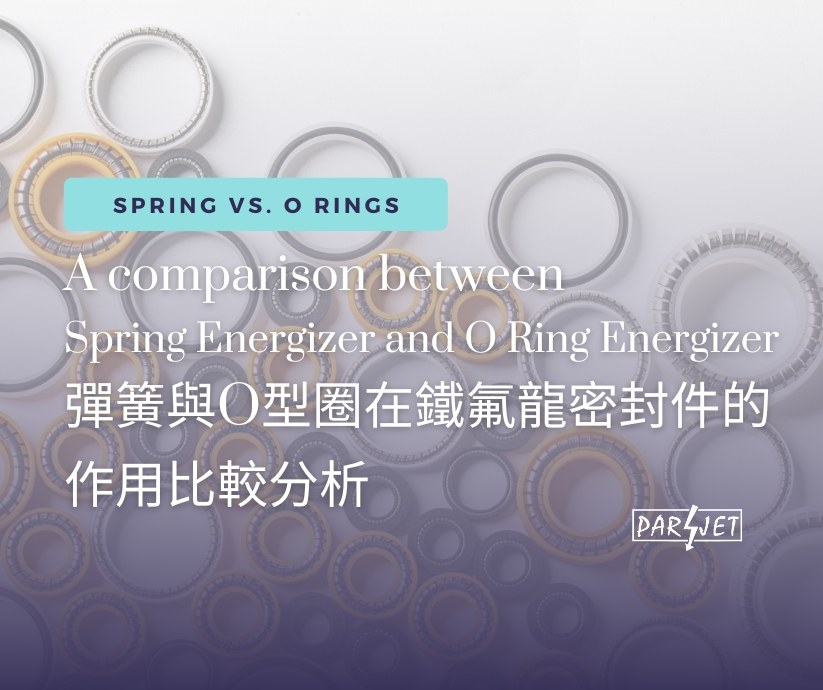A Comparison between Spring Energizer and O Ring Energizer
In the sealing world, the choice of energizers plays a crucial role in determining the performance, reliability, and longevity of energized seals. Among the various options, such as springs, o rings, silicones…, spring energizers and O-ring energizers stand out as popular choices. These energizers are typically installed in PTFE seal jacket. The two types each have their unique advantages and specific applications, however spring energizer stands out more than O rings in many aspects. This blog aims to provide a comprehensive comparison between spring energizers and O-ring energizers which help you make an informed decision for your sealing needs.
Understanding the Basics
Spring Energizer: Spring energizers are components that provide a consistent and reliable force for the seals to contact with the mating surface. The types of springs include canted coil springs, helical springs, cantilever springs and full contact springs. Read more about the differences between the springs here. They are typically used in dynamic sealing applications where the seal needs to accommodate varying pressures, temperatures, and movements. The spring element, often made from metal such as stainless steel or other corrosive resistance alloy like Elgiloy or Hastelloy to ensures continuous sealing performance even under harsh conditions.
O-Ring Energizer: O-ring energizers are elastomeric rings used to energize seals. They are commonly installed in static sealing applications but can also be used in certain dynamic scenarios. The O-ring energizer relies on its inherent elasticity to maintain the seal’s contact with the mating surfaces. They are often made from materials like nitrile, silicone, or Viton, which provide different levels of chemical resistance and temperature tolerance.
Key Differences
- Performance in Dynamic Applications:
- Spring Energizer: Ideal for dynamic applications due to its ability to maintain consistent force over a wide range of movements and pressures. The wide range of springs allows the seal to adapt different variations in the environment, providing reliable sealing even under challenging conditions.
- O-Ring Energizer: While capable of performing in some dynamic applications, O-ring energizers generally perform better for static applications. Their performance may degrade under constant movement and high-pressure fluctuations.
- Temperature and Pressure Tolerance:
- Spring Energizer: Excellent performance under high-temperature and high-pressure environments. The metal spring can withstand extreme conditions without losing its integrity, making it suitable for applications in aerospace, oil and gas, and heavy machinery.
- O-Ring Energizer: Depending on the material, O-rings can handle a range of temperatures and pressures, but they typically have lower tolerance compared to spring energizers. They tend to be compressed over time. They are best used in moderate conditions where extreme temperatures and pressures are not a concern. Additionally, unlike springs, where it holds in place, the O Ring can easily fall off from the seal jacket under high pressure conditions.
- Wear and Longevity:
- Spring Energizer: Offers superior longevity thanks to the robust nature of the metal spring. The consistent force provided by the spring minimizes wear on the seal, extending its service life. Additionally, springs with corrosive resistance materials allow the seal to function when sealing high corrosive media.
- O-Ring Energizer: The nature of elastomers causes the spring to wear out more quickly under dynamic conditions. They may require more frequent replacements, especially in harsh operating conditions. Additionally, some elastomer materials are unable to withstand under high corrosive environment which makes it challenging to survive in the extreme environments.
- Installation and Maintenance:
- Spring Energizer: Installation can be more complex due to the need to correctly position the spring within the seal however it is typically lower due to the extended service life and durability of the spring.
- O-Ring Energizer: Easier to install, however maintenance may be higher as O-rings can degrade faster and require more frequent checks and replacements.
- Cost Considerations:
- Spring Energizer: Due to the complexity of spring elements, they are generally more expensive. Nevertheless, its longer lifespan contributes to the reduced maintenance cost which can offset the initial cost over time.
- O-Ring Energizer: Typically, less expensive upfront, making them a cost-effective choice for less demanding applications. The higher replacement frequency, however, can lead to higher long-term costs.
Conclusion
Understanding the strengths and limitations of each type of energizer helps you make the right decision, ensuring optimal performance, reliability, and cost-efficiency for your sealing demand. Choosing between spring energizers and O-ring energizers depends on the specific requirements of the application. Spring energizers offer superior performance in dynamic, high-pressure, and high-temperature environments, making them suitable for demanding applications. It also reduces maintenance costs. On the other hand, O-ring energizers provide a cost-effective and simpler solution in the short term for static and moderate applications.
At Parjet
At Parjet, we offer a wide range of spring energized seals designs which are widely used in rotary, reciprocating and static applications. The spring options include canted coil springs, helical springs and cantilever springs. Additionally, we can customize all kinds of PTFE compound for seal jackets, such as carbon, glass fiber, bronze, Ekonol..etc. filled PTFE. For more information on spring energized seals, please visit here.
For other inquiries, please contact us here.






